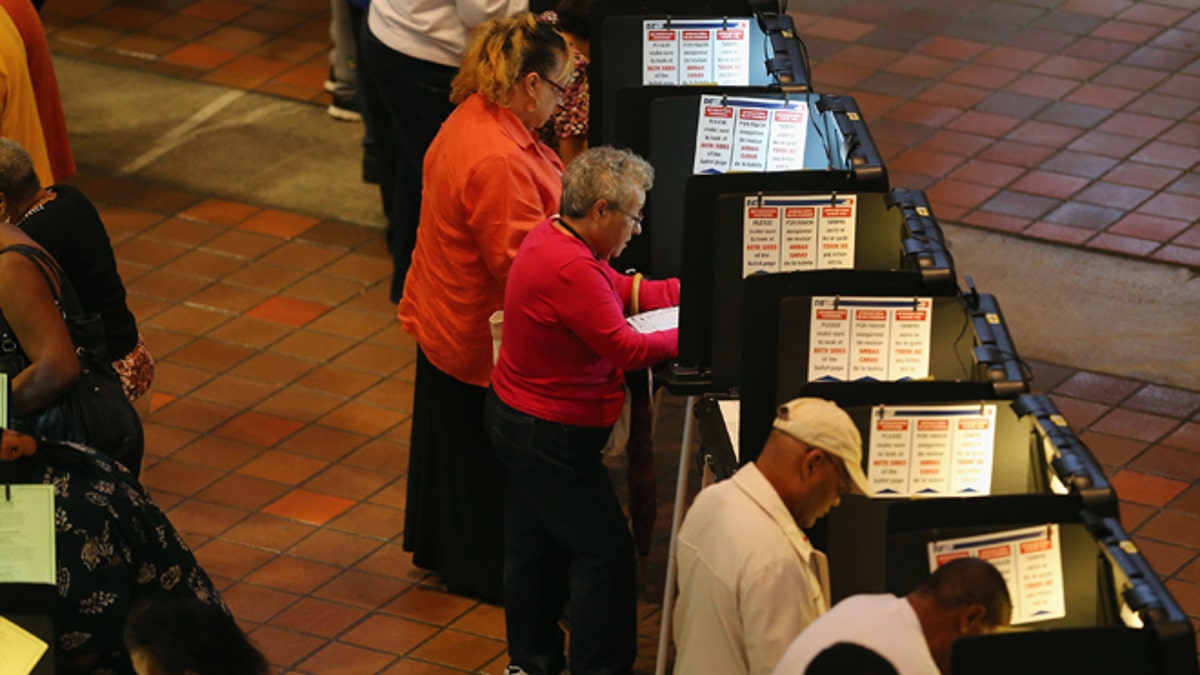
MIAMI, FL - OCTOBER 27: Early voters fill out their ballots as they cast their vote in the presidential election on the first day of early voting, at the Stephen P. Clark Government Center on October 27, 2012 in Miami, Florida. Early voting in one of the important swing states is held for eight straight 12-hour days, leading up to the November 6 general election. (Photo by Joe Raedle/Getty Images) (2012 Getty Images)
The share of Latino eligible voters has been growing steadily, making up a record 11 percent of all people who will be able to cast a ballot in November.
But they make up a small share of eligible voters in the states with close Senate and gubernatorial races, according to a new study by the Pew Research Center.
The study noted that a record 25.2 million Latinos are eligible to vote in November’s midterm elections, reflecting a rise of 3.9 million Latinos voters since 2010.
But in most of the roughly eight states with close Senate races, Latinos comprise less than 5 percent of eligible voters.
An exception is Colorado, where Latinos are 14.2 percent of eligible voters.
Colorado has emerged as a particular midterm election state for the fight between Republicans and Democrats for control of the U.S. Senate. Republicans need to pick up six additional seats in November to win control of the Senate from Democrats.
The latest polls for Colorado’s race show Republican challenger, U.S. Rep. Cory Gardner, leading the incumbent, Democrat U.S. Sen. Mark Udall, by several points. A Quinnipiac University poll has Gardner leading Udall 47 percent to 41 percent, and a CNN/Opinion Research Center one has Gardner ahead of Udall 50 percent to 46 percent.
Kansas is the only other state with a competitive Senate race where Latinos make up more than 5 percent of eligible voters – but not by much. In Kansas, Latinos are 6 percent of eligible voters.
“As a result, the impact of Latino voters in determining which party controls the U.S. Senate may not be as large as might be expected given their growing electoral and demographic presence nationwide,” the study said.
But even in states where Latinos have a greater voter share, they are dogged by low turnout.
While all groups tend to turn out at the polls in lower numbers in midterm elections, Latinos lag behind other racial and ethnic communities.
In 2010, 31.2 percent of Latino eligible voters cast ballots – far fewer than whites, who had a 48.6 percent turnout, and blacks, with 44 percent.
Part of the reason for the low turnout, the study said, is that Latino eligible voters include a larger share than other group of young people, who typically vote a lower rate than other age groups.
Another reason, the study said, is that many places with a large share of Latino eligible voters are not battleground states where high stakes draw more people to participate.
“We started this election cycle acutely aware that in the midterms you see all kinds of voters drop off,” said Emily Bittner, press secretary for the Democratic Congressional Campaign Committee.
“We put a high premium on communicating with Latino voters and youth voters. We made sure to start our earliest ever field program, going out and talking to voters door to door, and we found Spanish-speaking organizers.”
The effort to register voters for the midterm began about six months earlier than usual, Bittner said. Thus far they registered about 80,000 new voters, she said.
Republicans also have made efforts to court Latino voters, with many candidates running Spanish-language ads and even participating in Spanish-language debates, using interpreters if they're not fluent in the language.
“We are not taking a single vote for granted, every vote matters," said Ruth Guerra, a spokeswoman for the Republican National Committee. "We have staff on the ground working hand-in-hand with state parties and campaigns across the country to mobilize Latino voters in numerous states – including North Carolina, Virginia and Colorado."
"We will continue to reach Latinos where they live, work and worship to get them to the polls," Guerra said.
Latinos make up a large share of registered voters in places such as New Mexico and Texas, where they make up 40 percent and 27.4 percent, respectively. But those are not considered competitive places in November.
As for House elections, about 96 percent of Latino eligible voters live in districts that don’t have competitive races, Pew said.
Only nine states have close gubernatorial races, and those are largely in places that have a smaller share of Latino eligible voters.
Three states with competitive gubernatorial races have Latino eligible voter shares above 10 percent – Florida, which has 17.1 percent, Colorado, which has 14.2 percent, and Connecticut, which has 10.3 percent.
As for ballot initiatives, Latinos tend to share other voters' views on some issues, but not on others, such as gun control, abortion and federal minimum wage. About 62 percent of Latino registered voters support gun control, compared with 45 percent of all voters.
Latinos are split on abortion, while voters in general lean in favor of keeping abortion legal. About 84 percent of Latinos support raising the minimum wage to $10.10 an hour from $7.25, compared with 73 percent of all Americans.
Follow us on twitter.com/foxnewslatino
Like us at facebook.com/foxnewslatino




